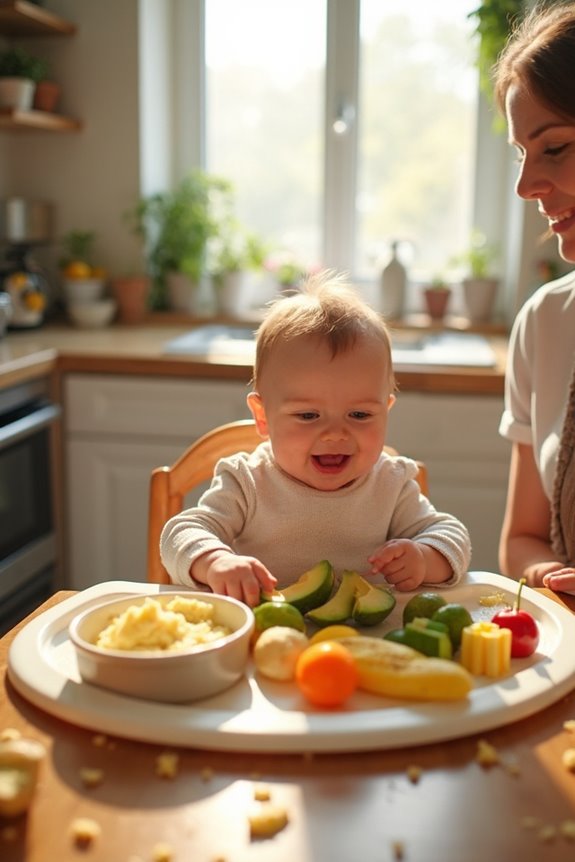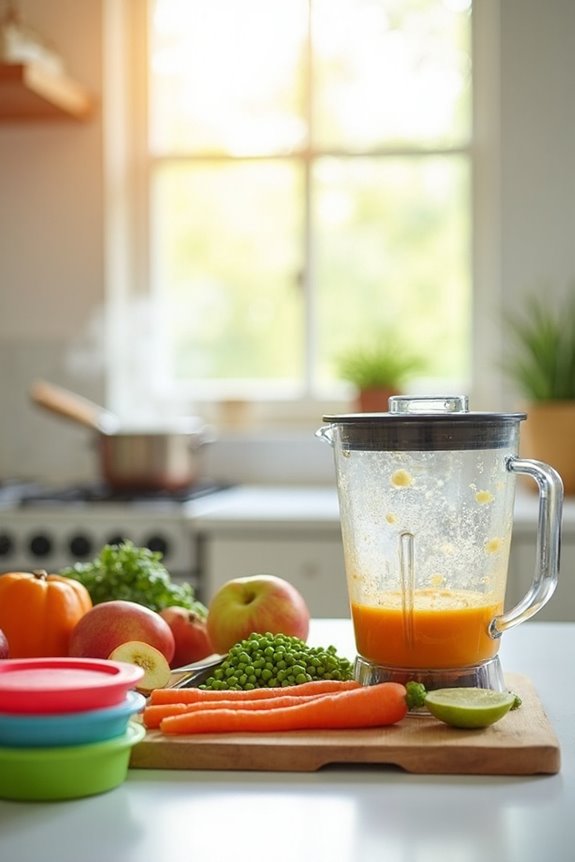Baby-led weaning is a unique way to introduce solid foods, where we let our little ones self-feed and explore family meals. Starting around six months, we focus on soft, graspable pieces of food that encourage our babies to learn and enjoy eating at their own pace. This approach not only boosts their confidence but also fosters a positive relationship with food. As we continue, we’ll share safety tips and suitable food options to help guide us on this journey.
Key Takeaways
- Baby-led weaning allows infants to self-feed solid foods, starting around six months when they show readiness signs.
- Parents serve soft, graspable pieces of family meals, encouraging exploration in a relaxed environment.
- This approach fosters confidence in infants’ self-feeding abilities and nurtures positive mealtime experiences.
- Safety is crucial; avoid choking hazards and supervise babies closely during meals to ensure safety.
- A balanced diet is important; introduce a variety of foods to promote diverse tastes and prevent nutrient inadequacy.
What Is Baby-Led Weaning?
Baby-Led Weaning (BLW) is an exciting approach to introducing solid foods that allows infants to take the reins during mealtime. Instead of spoon-feeding purees, we let our little ones explore whole foods, encouraging them to self-feed. Typically, we begin this journey around six months when our babies show key baby milestones like sitting up and coordinating hand-to-mouth movements.
With BLW, we focus on serving soft, graspable pieces of family meals, fostering a relaxed feeding atmosphere. This technique not only supports our babies’ nutritional needs but also helps them develop essential feeding skills. As we navigate this process together, it’s vital to ensure our little ones are developmentally ready and always supervised during mealtimes.
Benefits of Baby-Led Weaning

Exploring the benefits of Baby-Led Weaning can be an exciting journey for both parents and little ones. This approach not only fosters independence in our infants but also offers several psychological benefits for us as parents.
- Reduced Maternal Anxiety: Many mothers report feeling less anxious with this method.
- Increased Parental Confidence: Allowing our babies to self-feed boosts our belief in their abilities.
- Less Controlling Behavior: We engage more responsively, promoting a healthier relationship with food.
Additionally, baby-led weaning encourages a more relaxed attitude toward eating, which can lead to positive mealtime experiences. By embracing this style, we nurture not just our child’s development but also enhance our own parenting journey, creating meaningful connections during meals.
Safety Considerations

When we embark on the journey of introducing solid foods, safety must be our top priority. To ensure choking prevention, we should steer clear of firm, round foods like grapes and hard, crunchy items such as popcorn. Instead, focus on soft foods cut into manageable pieces. Continuous supervision during mealtime is essential, so we can react quickly if needed.
As we introduce allergens, let’s do it one at a time, offering each three times a week to monitor for any reactions. Keeping a record of foods and their effects can help us track our baby’s progress. Remember, a highchair provides support, and a clean, distraction-free environment sets the stage for safe, enjoyable meals.
Suitable Foods for Baby-Led Weaning

Introducing solid foods to our little ones can feel like a big adventure, and choosing the right options is crucial for a successful start. For baby-led weaning, we can explore a variety of delicious and nutritious foods.
Here are some great meal ideas:
- Protein-Rich Foods: Think fish, eggs, and yogurt.
- Iron-Rich Foods: Offer meat, beans, and lentils.
- Whole Grains: Toast, baby rice, and chapatti make fantastic bases.
- Vegetables: Serve avocado, sweet potatoes, and steamed broccoli.
- Fruits: Enjoy bananas, apples, and mangoes, perfect for little hands.
Combining these food options can make mealtime exciting, and we can encourage our babies to explore different textures and flavors. Remember, it’s all about letting them discover their tastes while we guide them!
Challenges and Drawbacks

Navigating the world of baby-led weaning can come with its share of challenges and drawbacks, even though the approach offers many benefits. One of our main concerns is choking hazards; while the risk isn’t necessarily higher than spoon-feeding, we must prepare foods properly and supervise closely. Messy mealtimes are another reality we face, as cleanup can be extensive.
Additionally, ensuring nutritional balance can be tricky. Babies might prefer certain foods, leading to calorie deficits or inadequate essential nutrients like iron and protein. We also need to offer a variety of foods to foster diverse tastes. By staying informed and prepared, we can tackle these challenges together, making the baby-led weaning experience safer and more enjoyable for everyone involved.
Evidence and Research on Baby-Led Weaning

Though baby-led weaning (BLW) has gained popularity among parents, understanding the evidence and research behind this feeding approach is essential for making informed decisions. While we often rely on observational studies, it’s important to recognize their research limitations. Most evidence comes from small trials that struggle to definitively address nutritional adequacy.
Key points to consider include:
- BLW promotes responsive feeding styles, which may positively impact breastfeeding duration.
- Concerns about iron and energy intake remain, but no solid proof shows nutritional inadequacy when well-planned.
- Families using BLW often enjoy mealtimes together, fostering a positive food environment.
Ultimately, while BLW has potential benefits, we must stay informed about the findings and plan our approach carefully.
Frequently Asked Questions
Can Baby-Led Weaning Be Combined With Traditional Spoon-Feeding?
Imagine a dance of flavors and textures; we can absolutely blend baby-led weaning with spoon-feeding. This hybrid approach allows us to embrace diverse feeding techniques, ensuring our little ones enjoy nutritious meals while developing independence.
What Should I Do if My Baby Refuses Certain Foods?
If our baby refuses certain foods, let’s stay patient and use refusal strategies. We can explore their food preferences, offer variety without pressure, and create a relaxed mealtime environment to encourage acceptance and exploration.
How Do I Clean up After a Baby-Led Weaning Meal?
After our messy cleanup, we’ve learned to make meal preparation easier. We keep cleaning supplies handy, start with small portions, and embrace the chaos—it’s all part of this beautiful journey together as our baby explores food!
Are There Any Specific Foods to Avoid During Baby-Led Weaning?
When we’re navigating baby-led weaning, we should steer clear of choking hazards and allergenic foods. Avoid raw veggies, whole nuts, and honey to keep mealtimes safe and sound for our little ones, together.
How Can I Encourage My Baby to Try New Foods?
To encourage our little ones to try new foods, we can create a fun, sensory experience. Let’s explore food together, allowing them to touch and taste, making mealtime an exciting adventure filled with food exploration.





